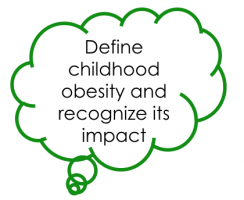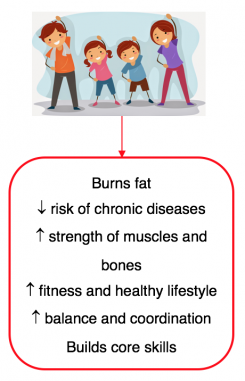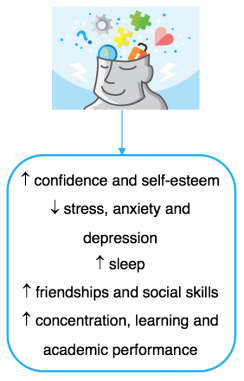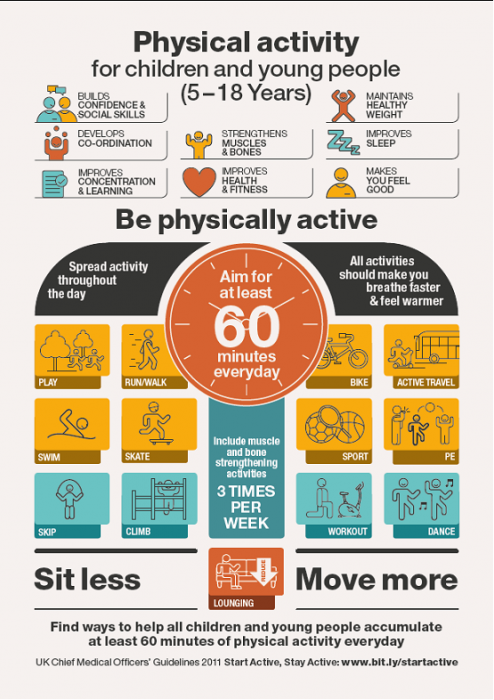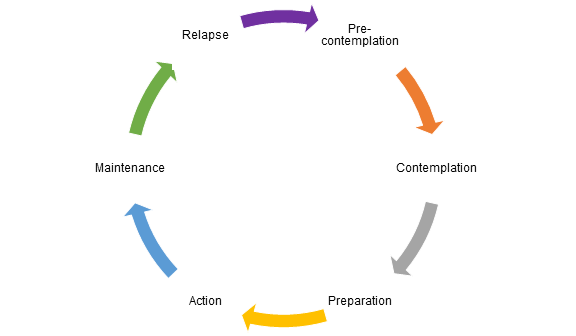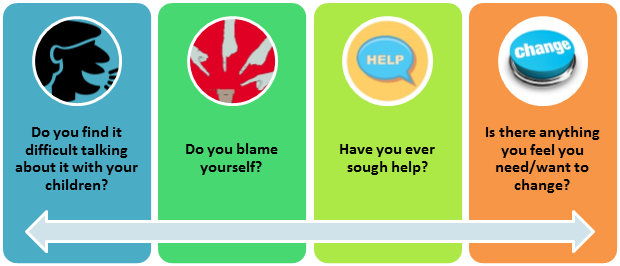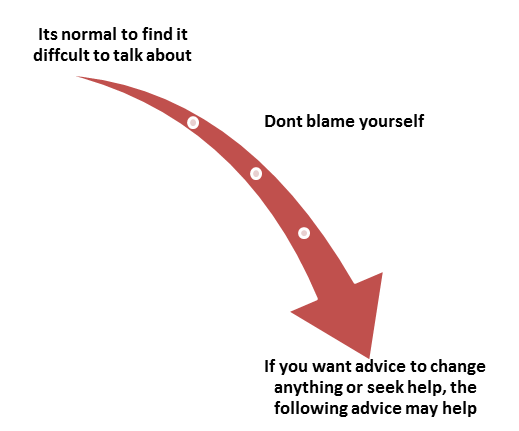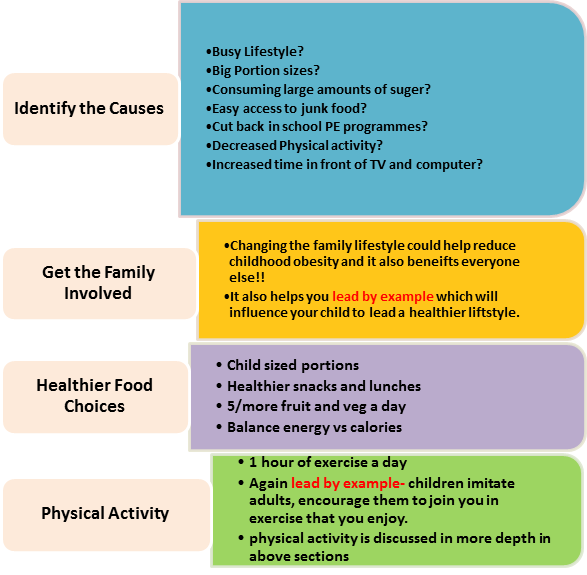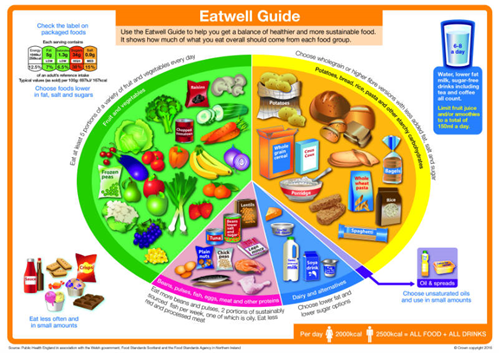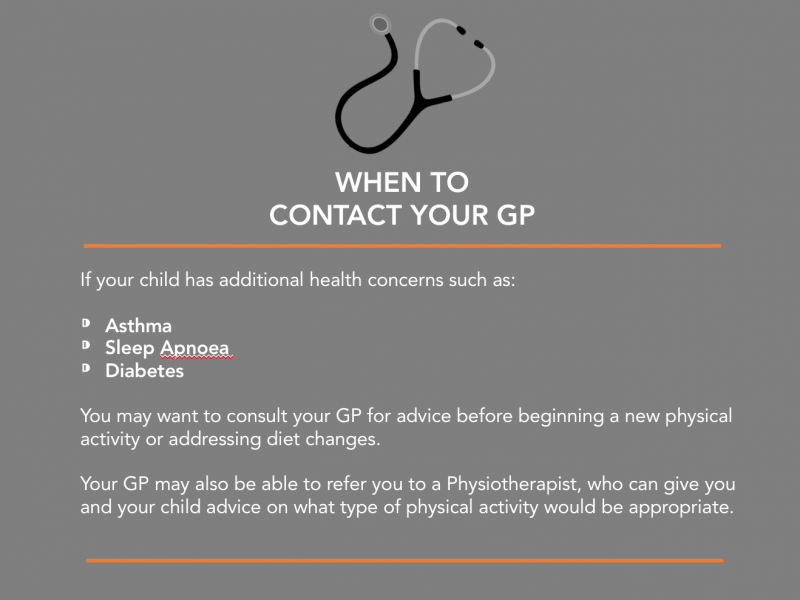Childhood Obesity
Original Editors - Alexander Dow, Andrea Civitarese, Lynne Turner, Alison O’Brien, Rachael Le Page, Courtney Ferguson
Top Contributors - Andrea Civitarese, Rachael Le Page, Lynne Turner, Kim Jackson, Lucinda hampton, Courtney Ferguson, Alison O' Brien, Alexander Dow and Rachael Lowe
WELCOME[edit | edit source]
Who is this page for?[edit | edit source]
The goal this page is to provide guidance and information to parents of overweight and obese children. We hope to give you some tools and resources in order to help you feel confident in managing your child's weight and activity levels.
By using this page, we hope you will be able to...[edit | edit source]
Click on a bubble above to jump to that section!
Obesity Overview[edit | edit source]
What is Childhood Obesity?[edit | edit source]
For adults, body mass index (BMI) is the method that is most commonly used to diagnose obesity. This method uses an individual's height and weight to establish whether or not they fall within a healthy weight range. BMI ranges are listed below:
- Healthy weight: BMI = 18.5-24.9
- Overweight: BMI = 25-29.9
- Obese: BMI = 30-39.9
- Severely Obese: BMI = ≥40
Calculate your child's BMI using the NHS Healthy Weight Calculator.
In children, BMI alone is not used to diagnose obesity, as children's bodies are constantly changing. To diagnose childhood obesity, paediatricians need to take many factors into consideration. Along with BMI, the paediatrician will take into consideration how your child is growing and developing, your family's history of obesity and related health problems (such as diabetes and heart disease), and your child's eating habits, activity levels, and general health.[1]
Why does this matter?[edit | edit source]
Check Point:
- Have a think. Does your child fall into the overweight or obese category?
- If yes, can you think of any habits that may be contributing to this?
- Now read the next section
What Are The Benefits Of Physical Activity For My Child?[edit | edit source]
Physical activity and inactivity can have a big effect on your child's health and development in many ways.
Regular activity[edit | edit source]
Having your child participate in regular physical activity will benefit their body and mind health in a variety of ways[3][4][5][6][7]:
Have a watch of this video which provides more details of the top 5 benefits of physical activity for your child with some research evidence.
Inactivity[edit | edit source]
You may find that your child enjoys playing video games and watching tv, however this leads to an inactive lifestyle which can have a bad effect on your child’s future health[5][6]. These effects may not show until later life but it is important to be aware of the higher risk of developing the following major diseases due to childhood inactivity[6]:
- Obesity
- Heart disease eg coronary heart disease
- Stroke
- Diabetes
- Cancer
- Mental health disease eg anxiety, depression and dementia
- Earlier death
Check point:
- Take some time and have a think:
- Are there any aspects of your child’s body and/or mind that you think would benefit from regular physical activity?
- Are you aware of the guidelines?
- Now read the next section
Physical Activity Guidelines for Children (Age 5-12)[edit | edit source]
How much physical activity do children (aged 5-12) need to be doing to stay health?
- Children (aged 5-12) should partake in at least 60 minutes of physical activity a day - this should range from moderate activity to vigorous activity.
Moderate Activity[edit | edit source]
Examples of activities which involve moderate exertion for children include:
- Walking to school
- Cycling on flat ground
- Playing in the playground
- Walking the dog
- Riding a scooter
- Rollerblading
Vigorous Activity[edit | edit source]
Vigorous activity is known to improve individuals general health, increase bone and muscle strength and improve self-esteem.
Vigorous activity can bring health benefits over and above that of moderate activity. Every one-minute of vigorous activity provides the same health benefits as two-minutes of moderate activity.
Examples of activities which involve vigorous execration for children include:
- Swimming
- Running
- Gymnastics
- Football
- Karate
- Rugby
Barriers and Facilitators to Managing Childhood Obesity[edit | edit source]
One of the key roles of health visitors and health professionals is to effectively present parents with the most up to date evidence on childhood obesity and interventions. Factors such as race, ethnicity, lifestyle, genetics, culture, socio-economic status, and the environment tend to have great influence on dietary choices[9]. Dealing with obesity is a complicated process, which involves a broad sociological awareness and understanding. It also requires tactful and compassionate communication skills that can influence behaviour and bring about positive lifestyle changes by breaking down barriers and identifying facilitators.
Barriers: are things that get in the way[edit | edit source]
Resources Barriers
- Financial resources. financial barriers can be a massive barrier to physical fitness especially for large families.
- Limited time. work hours for parents can be a barrier to family exercise, especially if having to work during evenings or on weekends,
- Access to programs. access to exercise programs can often be limited in areas or for certain age groups,
- Knowledge gaps. incomplete knowledge surrounding healthy eating[10] [11],
Social Barriers
- Cultural practices and expectations. cultural differences can contribute to difficulty in maintaining a healthy diet.
- Interpersonal dynamics. challenging family dynamics such as shared custody can make maintain a healthy eating and exercise routine can be very challenging[12].
Emotional Barriers
- Lack of confidence. uncertainty over their ability to control their child’s weight,
- Defeat. feelings of defeat related to previous failed attempts at weight management
- Loneliness. adolescents in particular often described feelings of isolation and loneliness related to their overweight status
- Denial. despite their involvement with the medical system, According to [10] [11],most parents are unwilling to accept that their child has a weight issue.
- Negative attitudes. from parents, staff and peers can hinder your child’s interest in physical activity[13]
- Embarrassment. vulnerability, disappointment and shame at appearing physically incapable are just some of the emotions your child may experience
Check Point:
- Have a think, what are the main barriers that come to mind for you
- Write down the main barrier
- Now read the next section
Facilitators: are what can make it easier[edit | edit source]
Building Partnerships
- the importance of building strong partnerships between patients, families, schools and health care providers is essential[14]
- specifically discussed goal setting in collaboration with providers as a helpful element for weight management[15].
- engaged as an entire unit, so that parents and children could better partner to achieve goals around healthy living.
- GP or practice nurse can refer you to a local weight management programme for children, such as MEND and More Life.
Access to Resources
- primary care centre directly providing programs, including fitness classes, nutrition courses, and cooking classes
- showing parents and children how to create a healthy snack that not only looks good but tastes good.
- access to support groups could be a helpful resource and nutrition education classes
- access to free local community programmes and after school clubs
- clearer signposting to available resources
Consistent Encouragement
- the use of consistent encouragement by providers needs to be a key component of successful weight management.
- use of technology (eg, via text-messaging or email) for providing ongoing encouragement related to weight management between visits
Check Point:
- Look at the barrier you wrote down
- Can you now think of a facilitator that could make it easier to overcome
- Repeat this exercise for all of the barriers you thought of
- Now read the next section
Stages of Change Model [edit | edit source]
Before change can be implemented it is completely normal to go though stages to making these changes a reality, this is referred to as the Stages of Change.
The stages of change are:
- Pre-contemplation (Not yet acknowledging that there is a problem behaviour that needs to be changed)
- Contemplation (Acknowledging that there is a problem but not yet ready or sure of wanting to make a change)
- Preparation/Determination (Getting ready to change)
- Action/Willpower (Changing behaviour)
- Maintenance (Maintaining the behaviour change) and
- Relapse (Returning to older behaviours and abandoning the new changes)
Managing Childhood Obesity as a Parent[edit | edit source]
Before you read this section, it could be beneficial to think of how you are managing now?
Maybe ask yourself some of these reflective questions to help you determine any area that you feel you need help or advice with;
After you have thought about the reflective questions remember;
Some resources that you might find helpful;
Note: Be aware parents that if you plan to change your child’s diet, remember to consult your GP or dietician first.
· Here is a useful link for some fun ideas for healthy school lunches and snacks; https://www.bbcgoodfood.com/howto/guide/school- packed-lunch-inspiration
· A useful image to help guide on how much food your child should be eating from each food group;
Checkpoint:
- Do you feel more empowered and reassured after asking yourself the reflective questions?
- Do you feel there are changes you could make?
- If you like make a list of some changes you could make to manage childhood obesity.
Local Opportunities for Physical Activity in Edinburgh[edit | edit source]
Here is a list of some local activities and sports and online apps that are available which may give you some ideas of how to help you child become more physically active. Click on the wording in blue to go to the website and find out some more information.
[null Gyms]
Gyms, activities and sports teams[edit | edit source]
It is good to know that some gyms in Edinburgh provide loads of facilities and classes for your children.
These are just a selected few;
- Virgin Active Gym – have plenty of fun varied classes for you and your kids such as swimming, balloon volleyball, musical games and crafts
- Energy Gym – this gym has some great fitness options for your children. They have a great understanding of the challenges to get kids to exercise. They have gymnastics classes, a cross-fit youth club and dance classes.
- Edinburgh Leisure – they have loads of activities that can cater to everyone’s interests some which include-swimming, tennis, football, racquet sports, soft play, and climbing and rock sports.
Edinburgh City Council
Edinburgh City Council provide a lot of information on a wide-range physical activities and sports some which include;
- Football
- Cricket
- Golf
- Badminton
- Cycling
- Rugby
They also have sports clubs such as;
- Sports Club Edinburgh - which lets you find your nearest sports club to your location and what facilities they have to offer.
- Dance classes- the link to the website below lets you search for local dance classes in your area.
- Activities for under 5s - provide fun play activities ideas from ages 0-10.
- Play Parks- If you simply want to know where some of the nearest play parks are to you in the city or simply want to find a park near your children’s school.
This link provided takes you to the Edinburgh City Council website with additional information and all the details on the different sports and activities that are available in your area.
Apps[edit | edit source]
Here is a list of free apps online that will encourage your child to perform physical activity and also provide ideas of activities. This is not an exhaustive list and there is a wide variety and many more apps available.
- HOOP: Find and book fun things to do in your local area for children aged 0-11 years old. (iOS & Android)
- Kiddy Keep Fit by Scotty & Lulu: Uses music and games to get children moving and exercising. (iOS)
- 7-minute workout for kids: High intensity workouts with rests to develop strength, stability and balance. (iOS)
- Habitz: Set up by Health Professionals to help parents to inspire their children to develop healthy habits and lifestyles. (iOS)
- Sworkit Kids – Fitness Meets Fun (7-14 year olds): Wide variety and duration of fun exercises to develop and enhance strength, agility and flexibility. (iOS & Android)
- Appu’s Yoga for Kids: Easy yoga poses for children to enhance and refresh your child's body and mind. (iOS & Android)
- Wuf Shanti Yoga Fun Machine: Yoga app using games and music to promote health and happiness for your child through yoga, meditation and mindfulness. (iOS)
When to ask for help... And who to ask[edit | edit source]
Check point:
Now you have read all of the above information we hope it has answered any questions you may have and provided you with useful information and some ideas to help with your child’s weight or obesity.
Now take some time to make a plan of what you would like to do and the goals that you would like to achieve with your child and family in the next:
- 1 week
- 1 month
- 6 months
- 1 year
Conclusion[edit | edit source]
We hope that this page has provided you with tools and information that will be practical and useful for you and your family. Please see the "Useful Links" section below for further resources, and feel free to use this page as a reference whenever you need it.
Useful Links[edit | edit source]
- NHS Choices: What can I do if my child is very overweight?
- Article: TV in bedroom 'risk factor' for child obesity
- BBC: What to do if your child is overweight
- NHS: Change 4 Life
- NHS Livewell: advice for children health ages 6-15
- Families online: child-wellbeing
- CDC Government: Obesity causes
- MEND Foundation
- More Life
References[edit | edit source]
see adding references tutorial.
- ↑ Mayo Clinic. Childhood Obesity Diagnosis. https://www.mayoclinic.org/diseases-conditions/childhood-obesity/diagnosis-treatment/drc-20354833 (accessed 31 March 2018).
- ↑ Childhood Obesity in the UK Available from: https://www.youtube.com/watch?v=5Km1fFLX6T8 [last accessed 15/03/18]
- ↑ Gov.UK. Publication: Start active, stay active: infographics on physical activity [/www.gov.uk/government/publications/start-active-stay-active-infographics-on-physical-activity https://www.gov.uk/government/publications/start-active-stay-active-infographics-on-physical-activity] (accessed 02 April 2018)
- ↑ SSEHS ACTIVE. Interpreting the UK physical activity guidelines for children. [/www.ssehsactive.org.uk/young-people-resources-and-publications-item/39/443/index.html http://www.ssehsactive.org.uk/young-people-resources-and-publications-item/39/443/index.html] (accessed 02 April 2018)
- ↑ 5.0 5.1 GREAT ORMOND STREET. Exercise for children and young people [/www.gosh.nhs.uk/medical-information/general-health-advice/leading-active-lifestyle/exercise-children-and-young-people https://www.gosh.nhs.uk/medical-information/general-health-advice/leading-active-lifestyle/exercise-children-and-young-people] (accessed 02 April 2018)
- ↑ 6.0 6.1 6.2 KOHL III, H. W., and COOK, H. D. Educating the Student Body: Taking Physical Activity and Physical Education to School. Washington: The National Academies Press [/www.ncbi.nlm.nih.gov/books/NBK201497/ https://www.ncbi.nlm.nih.gov/books/NBK201497/] (accessed 02 April 2018)
- ↑ SSEHS ACTIVE. Children and young people evidence briefing. [/www.ssehsactive.org.uk/resources-and-publications-item/40/475/index.html http://www.ssehsactive.org.uk/resources-and-publications-item/40/475/index.html] (accessed 02 April 2018)
- ↑ 5 Reasons Why Physical Activity is Important for Children Available from: https://www.youtube.com/watch?v=nD-0Wc6eSUE [last accessed 28/03/18]
- ↑ El-Sayed, A.M.; Scarborough, P.; and Galea, S. (2011) Ethnic Inequalities in Obesity Among Children and Adults in the UK: A Systematic Review of the Literature. Obesity Review. 12 (5).
- ↑ 10.0 10.1 Keenan, J.; and Stapleton, H. (2010) Bonny Babies? Motherhood and Nurturing in Age of Obesity. Health, Risk&Society, 12 (4).
- ↑ 11.0 11.1 Redsell, S.A.; Atkinson, P.; Nathan, D.; Siriwardena, A.N.; Swift, J.A.; and Glazebrook, C. (2010) Parents’ Beliefs about Appropriate Infant Size, Growth, and Feeding Behaviour: Implications for the Prevention of Childhood Obesity. BMC Public Health, 10 (711).
- ↑ Barriers and Facilitators of Pediatric Weight Management Among Diverse Families Lauren Brown, BA1,2, Sarah-Bianca Dolisca, BS3 , and Jennifer K. Cheng, MD, MPH3,4 Clinical Pediatrics 2015, Vol. 54(7) 643–651 © The Author(s) 2014 Reprints and permissions:
- ↑ Larsen, L.M.; Ledderer, L.; Jarbøl, D.E. (2015) Management of Overweight during Childhood: A Focus Group Study on Health Professionals’ Experiences in General Practice International Journal of Family Medicine. Volume 2015, Article ID 248985
- ↑ Shields N, Synnot A. Perceived barriers and facilitators to participation in physical activity for children with disability: a qualitative study. BMC pediatrics. 2012 Jan 19;16(1):1.
- ↑ Redsell, S.A.; Atkinson, P.; Nathan, D.; Siriwardena, A.N.; Swift, J.A.; and Glazebrook, C. (2013) UK Health Visitors’ Role in Identifying and Intervening with Infants at Risk of Developing Obesity. Maternal and Child Nutrition, 9 (3).



